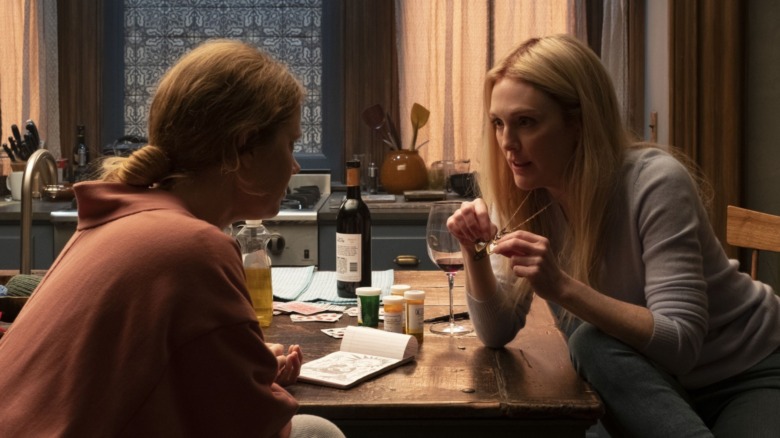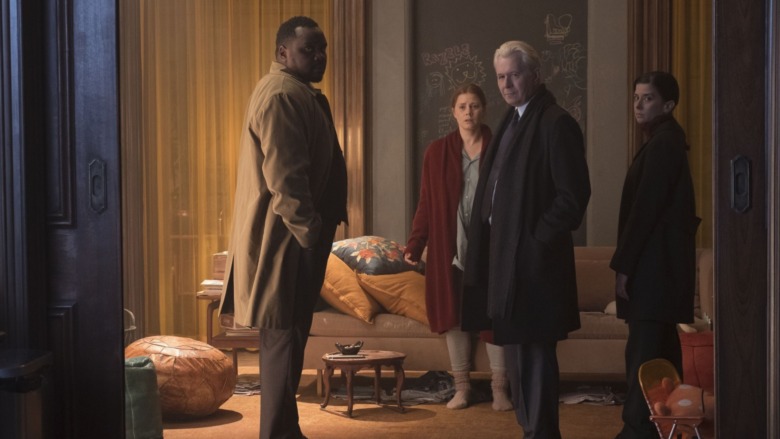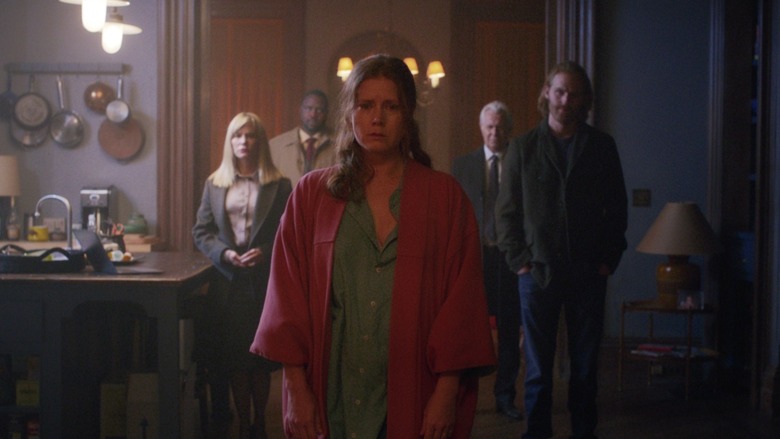Amy Adams: The One Woman In The Window Scene That Makes Us Love Her Even More
This content was paid for by Netflix and created by Looper.
Perennial Oscar and SAG-nominee Amy Adams is a true triumph in the new psychological thriller "The Woman in the Window." Although the actress turns in exceptional performances in every project she appears in, the character Anna Fox gives Adams the opportunity to explore the entire spectrum of human emotional experiences. To nobody's surprise, Adams absolutely nails it.
Adams stars in "The Woman in the Window" as an agoraphobic woman who spends her time spying on her neighbors, drinking wine, and cozying up with her cat. It's far from a perfect life, and it gets even worse when Anna witnesses a murder taking place in the house across the street. If that weren't terrible enough, Anna is also the very definition of an unreliable narrator. She not only has to prove what she saw to the police. She has to convince herself, as well.
Adams' performance in the film is sensational from start to finish, but there's one sequence in particular that showcases just how much power the actress brings to this role. Here's a look at the scene in "The Woman in the Window" that makes us love Amy Adams even more.
Building a mystery
Throughout "The Woman in the Window," Adams' performance makes it clear that her character has endured some kind of massive trauma, but the tragic details of Anna's past don't come to light until she's forced to face the truth all over again. This devastating reality check is set in motion after Anna meets a woman played by Julianne Moore, who Anna believes is her new neighbor, Jane Russell. "Jane" comes to Anna's rescue during a difficult confrontation with some pranksters, and the two get along very well. So, as you can imagine, Anna is horrified when she sees someone stabbing Jane through the window. After calling the police, Anna even braves the outdoors to try and help.
However, Anna then meets the "real" Jane Russell, played by Jennifer Jason Leigh. Even the Russells' son, Ethan, casts doubt on Anna's story. But Anna doesn't give up. Instead, she decides to do some detective work of her own. Soon, Anna finds herself on the defensive, threatened with a digital photo that was taken while she was sound asleep. This leads to an epic confrontation between the police, the Russell family, Anna's tenant, and Anna's own repressed memories. It's a scene filled with other talented stars, all operating at the top of their games, and yet Adams still dominates the screen. Here's how.
Pointing fingers
The scene is tense from the very start. Anna consults with the police who investigated her report about Jane's murder, and quickly realizes that they don't believe anything she's saying. They even imply that she may have faked the creepy photograph that's causing her so much distress. For Adams, it's a moment filled with disbelief and desperation. Anna insists that she is in danger, and yet the police doubt her instead of protecting her.
Things escalate even further when the "real" Jane and her husband Alistair, portrayed by Gary Oldman, barrel in and confront Anna about her unwelcome investigation into their family. Anna accuses Alistair of abusing Ethan, offering a picture drawn by the other Jane as proof of the woman's existence. Alistair insists that Anna is delusional. Adams lets loose with all of the ire and disgust Anna has for the Russell family patriarch, but before things can build even further, Anna's tenant David, played by Wyatt Russell, stumbles into the room, stealing everyone's attention.
That's when Anna's story begins to deteriorate. As Anna saunters through the room, literally pointing fingers at everyone, Adams portrays her as someone who truly believes what she's saying. She accuses David of hiding a relationship with Jane. She repeats the abuse allegations against Alistair. And yet, while Anna's words lay out a strong case, Adams' body language says otherwise. Adams adopts an isolated and defensive posture as Anna continues her accusatory monologue, layering in subtle physical signs of self-doubt even as Anna quietly insists that she's not hallucinating.
Over time, Adams begins to dominate the screen, turning in a commanding performance even as Anna struggles to reconcile her certainty that Alistair is an abuser and a killer with the realization that nobody believes her. This is when Anna's anguish peaks, leaving her vulnerable to the world-shattering reveal that follows.
Looking back
Although Anna realizes how ludicrous her story sounds, she still tries to appeal to Detective Little, portrayed by Brian Tyree Henry, by playing on his sympathies as a parent. Little might not believe Anna's tale about the other Jane, but Anna still wants him to protect Ethan. But things quickly take a dark turn. The lights begin to dim as Anna insists that the detective can't let something bad happen to a child, as Adams' line delivery goes from adamant to devastated. That's when the bomb drops: As Little's partner reveals, Anna's own family is dead.
In that moment, Adams transforms. Without missing a beat, Adams' face seamlessly shifts into a smile as Anna recalls a conversation with her daughter in the car. But it's not necessarily a happy memory. Moments later, we learn that Anna had a broken relationship with her husband Ed, played by Anthony Mackie. An argument between the couple regarding Anna's infidelity plays out on screen, leading to a car crash that kills both Ed and Anna's daughter.
As Anna's mind returns to real time and she remembers that her attempts to save her family were futile, Adams' energy fades. Suddenly, Anna realizes that she very well may have hallucinated, well, everything. After all, Anna just had a very visceral experience reliving the worst night of her life. It's just as plausible that Detective Little is right, and that everything else Anna has seen has been a side-effect of her medication and her wild imagination.
We've seen Adams portray characters who have to face terrible truths about themselves in films like "Hillbilly Elegy" and the superb sci-fi drama "Arrival," but here, Anna's troubles are compounded even further by the fact that she may be continuing to harm others. Anna doesn't even let the Detective Little finish speaking before she begins apologizing to everyone. In contrast to the fiery delivery of Anna's monologue, Adams suddenly sounds sincere. She's rightfully shocked, and Adams milks it for all its worth.
The Russells are still hiding some disturbing secrets, and Anna's journey is far from over. However, this one scene forces Anna to confront her own dark past, and makes her face the fact that she has been living in denial for years. A furious start, a heartbreaking interlude, and a sobering moment of self-awareness: this one scene from "The Woman in the Window" is unforgettable, and showcases what a powerhouse performer Amy Adams truly is.


